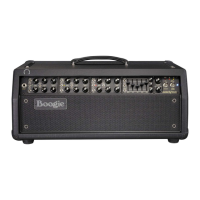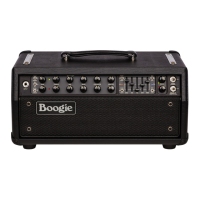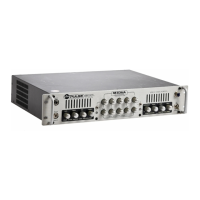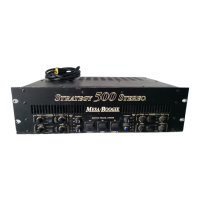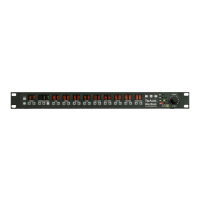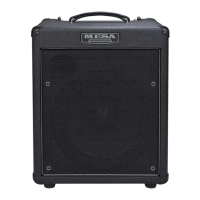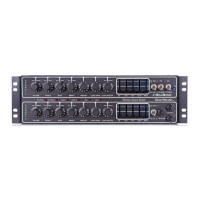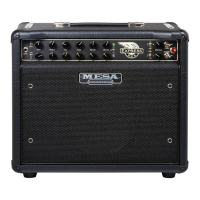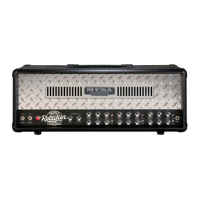PAGE 33
One clue is price. As with most segments of the marketplace, you get what you pay for most times, and there
is a wide range of quality in regard to both build quality and sonic performance. While technology has raced
ahead and features are at an all-time pinnacle, it is the sound and feel for which you’ve likely chosen your pure
analog all-tube amplifier. Therefore, we recommend a similar degree of discretion when it comes to choosing
your processing devices. Ultimately, what you insert in the middle of your amplifier’s signal path will have a lot
to do with how it performs.
To connect your Processors via the Eects Loop:
1. Connect the SEND to your processor’s INPUT.
2. Connect the RETURN to your processor’s OUTPUT.
NOTE: If your processor has Stereo OUTPUTS – or is Stereo IN and OUT - connect the Mono connections of the processor
to the MARK VII Loop’s SEND and RETURN. Most Stereo processors provide a Mono option on the Inputs and Outputs, and
most times, though not always, the Mono signal is processed in the LEFT Channel. In some cases, you may be able to con-
nect the additional (output) channel of a stereo processor to another amplifier source to achieve a stereo eect.
NOTE: Keep in mind that connecting two amplifiers in the above manner can result in ground loops and unwanted noise
from the amplifiers having diering Ground references. This is sometimes remedied by lifting one of the amplifier’s circuit
to chassis Ground, and depending on the amplifiers, this might be a switchable feature. DO keep the MARK VII Grounded
in this scenario (don’t disconnect the Ground prong on the Power Cable) as it needs to remain grounded to help prevent
the risk of shock. Alternatively, there are buers and isolating devices on the market, including some made by us here at
MESA, that can help with these types of grounding issues. Call your local music retailer to investigate your options should
you experience these unwanted noises when connecting two amplifiers in this manner.
It is always best to use the shortest cable lengths possible when patching in your processors. If you intend to
run very long cable lengths, use a buer. Even though the amplifier’s Eects Loop IS buered, there can be
some minimal sonic penalty the longer the cable length becomes.
Always use shielded, high-quality cables to connect your processors to the Eects Loop. One way to check the
quality of your processors and also match the levels is to do this simple test: Set up a sound without processors
in the Loop. Listen to the sound and observe the feel. Insert your processing into the Loop and do the same.
Remove the SEND and RETURN cables from the MARK VII, and if the sound gets better or the level jumps up,
you will know that either your processor’s levels are set too low and need adjustment, or perhaps the proces-
sor’s output section is in question or not a good match.
If unplugging the cables from your Eects Loop reduces the signal level, simply lower the Input and/or Output
Levels on the processor(s). Repeat the test until there is no - or very little - dierence in levels when the Eects
Loop patch cables (processors) are inserted and removed from the Eects Loop.
MESA FTSW
This 7-Pin DIN style jack accepts the 7-Pin DIN connector supplied with the MESA Footswitch. Connection of
the Footswitch here oers you instant control of the Channels and switchable Features on the MARK VII when
MIDI messages ARE NOT going to be used to control the amplifier.
NOTE: DO NOT connect both the MESA Footswitch and a MIDI Controller to the MIDI IN at the same time. Doing so may
result in damage to your amplifier not covered under its Warranty.
MIDI
These standard DIN Jacks accept and pass on the MIDI signals that control the Channel and feature switching
in your MARK VII. See the MIDI Implementation Section in this Manual for instructions on how to use MIDI to
control your amplifier.
NOTE: DO NOT connect both the MESA Footswitch and a MIDI Controller to the MIDI IN at the same time. Doing so may
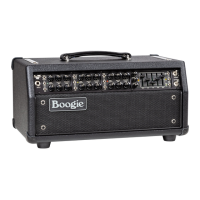
